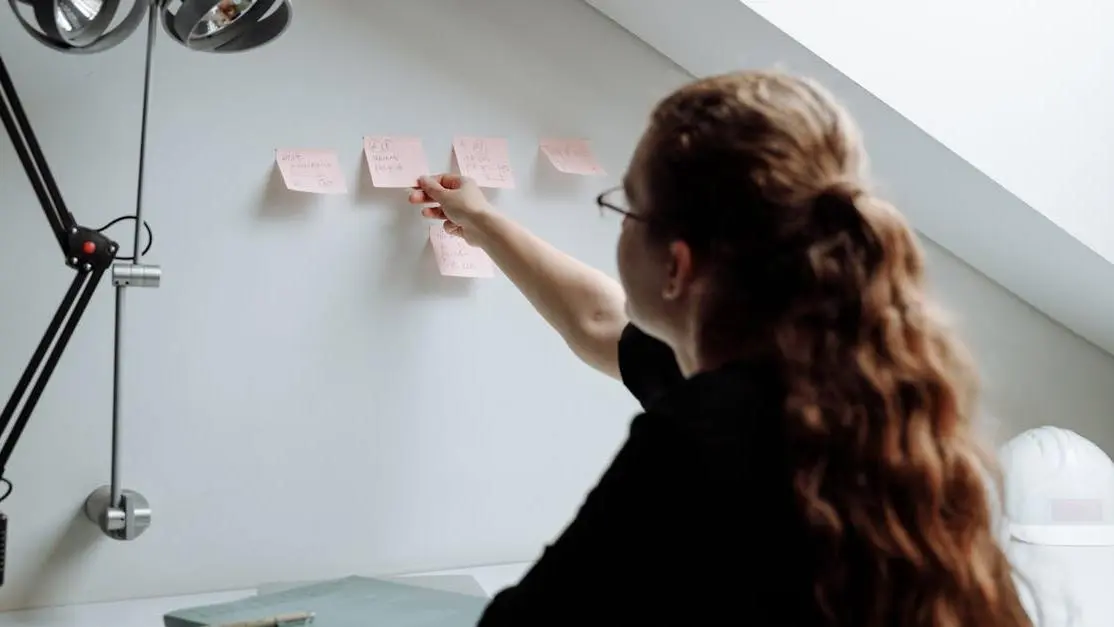Feeling overwhelmed by unending to-do lists?
Discover productivity techniques that can transform your daily routine. In this article, we explore actionable strategies that boost efficiency and enhance focus.
Say goodbye to stress and hello to a more productive you!
- 1. Time Blocking for Focused Work
- 2. The Pomodoro Technique: Work in Bursts
- 3. Eisenhower Matrix to Prioritize Tasks
- 4. Eat That Frog: Tackle Tough Tasks First
- 5. The Two-Minute Rule for Quick Wins
- 6. Getting Things Done (GTD) Method
- 7. The 80/20 Rule (Pareto Principle)
- 8. Use of To-Do Lists and Daily Goals
- 9. Kanban Boards for Visual Task Management
- 10. Mind Mapping for Creative Problem Solving
- 11. Batch Processing Similar Tasks
- 12. The ABCDE Method for Task Prioritization
- Scheduled Breaks and Leisure Time
- Choosing the Right Productivity Technique for You
- Why Having a Productivity Method is Crucial
- Conclusion: Take Charge of Your Productivity
1. Time Blocking for Focused Work
Imagine a day where every task gets its dedicated slot, preventing distractions and ensuring you stay focused. That’s the magic of Time Blocking. At Peak Performance, we swear by this powerful technique to reclaim our time and turbocharge productivity.
How it Works:
By assigning specific time blocks to your varied tasks, you create a structure for your day. No more juggling multiple projects simultaneously. Instead, you concentrate on one task at a time. This minimizes context switching, which is a productivity killer.
Steps to Implement Time Blocking:
- List Your Tasks: Start with a master list of everything you need to do.
- Prioritize: Identify the most crucial tasks (we’ll talk about prioritization in the Eisenhower Matrix section).
- Assign Time Blocks: Allocate specific times during your day to focus on each task. Include breaks to avoid burnout.
- Stick to the Schedule: Focus on one task during its allocated time block. Resist the urge to multitask.
Tips for Successful Time Blocking:
- Day Theming: Dedicate whole days to specific themes or types of work.
- Adjust and Adapt: Be flexible. Some tasks may take longer than anticipated.
Benefits: Increased focus, better time management, and less stress as you tackle one task at a time.
2. The Pomodoro Technique: Work in Bursts
Are you tired of facing endless hours of work with no respite? Enter the Pomodoro Technique – designed to keep your mind sharp and productivity high, especially for those needing regular breaks.
How to Use the Pomodoro Technique:
- Choose a Task: Pick an important task you want to work on.
- Set a Timer: Set a 25-minute timer, signaling the start of a “Pomodoro.”
- Work Intensely: Focus solely on the task until the timer rings.
- Take a Short Break: Reward yourself with a 5-minute break.
- Repeat: After four Pomodoros, take a longer break (15-30 minutes).
Advantages:
- Boosts Focus: Breaks work into digestible chunks, improving concentration.
- Reduces Burnout: Regular breaks help prevent fatigue, keeping your mind fresh.
- Tracks Progress: Each Pomodoro is a productivity unit, showing progress over time.
By implementing the Pomodoro Technique, you train your brain to operate efficiently, maintaining focus and reducing fatigue.
3. Eisenhower Matrix to Prioritize Tasks
Struggling to figure out which task to tackle first? Let the Eisenhower Matrix guide you. Created by Dwight D. Eisenhower, this method helps you separate urgent tasks from those that are just important, allowing for better decision-making.
How the Eisenhower Matrix Works:
- Urgent/Important: Tasks that need immediate attention and align with your long-term goals.
- Not Urgent/Important: Tasks that are significant but don’t require immediate action.
- Urgent/Not Important: Tasks that need to be done quickly but don’t significantly impact your goals.
- Not Urgent/Not Important: Tasks that are low priority and can be delegated or deleted.
Steps to Use the Eisenhower Matrix:
- Categorize Tasks: Divide your tasks into the four quadrants.
- Act Accordingly: Focus on Quadrant I tasks first, schedule Quadrant II tasks, delegate Quadrant III tasks, and consider eliminating Quadrant IV tasks.
Benefits: This matrix encourages you to concentrate on high-impact activities, ensuring your efforts align with your priorities, reducing stress, and improving efficiency.
4. Eat That Frog: Tackle Tough Tasks First
Feeling overwhelmed by your to-do list? It’s time to Eat That Frog. Coined by Brian Tracy, this technique involves tackling your most challenging task first. Taking on the hardest task early ensures that everything else seems manageable in comparison.
Steps to Eat That Frog:
- Identify Your Frog: Pinpoint the most critical task that you’re most likely to procrastinate on.
- Do It First: Start your day with this task. Completing it will give you a sense of accomplishment.
- Repeat Daily: Make this a daily habit to continually tackle high-priority tasks first.
Why It Works:
- Reduces Procrastination: By addressing the most daunting tasks first, you avoid procrastination.
- Boosts Productivity: Accomplishing critical tasks early frees up your day for other activities.
- Builds Confidence: Overcoming challenging tasks builds momentum and confidence.
Pro Tip: Combine this technique with time blocking to allocate ample time for your “frog.”
5. The Two-Minute Rule for Quick Wins
Ever feel weighed down by minor tasks? The Two-Minute Rule can help. If a task takes two minutes or less, do it immediately. Developed by productivity guru David Allen, this technique helps clear your mental clutter.
How to Use the Two-Minute Rule:
- Immediate Action: If a task can be completed in two minutes or less, do it right away.
- Apply Broadly: Use this rule for emails, phone calls, filling out forms, etc.
- Examples: Replying to an email, tidying your workspace, making a quick phone call.
Benefits:
- Eliminates Procrastination: Quick wins clear small tasks off your plate immediately.
- Boosts Efficiency: Focus on longer tasks without small interruptions.
- Reduces Mental Clutter: A clean mental slate enables better focus on larger tasks.
Adopt this rule to keep your workflow smooth and reduce the interruptions caused by minor tasks.
6. Getting Things Done (GTD) Method
Are you seeking a holistic approach to productivity? The Getting Things Done (GTD) method by David Allen could be your solution. GTD breaks down tasks into manageable steps, liberating mind space for more creative and productive thinking.
How GTD Works:
- Capture: Collect what has your attention. Use a physical inbox, notepad, or digital tool.
- Clarify: Process what each item means and identify the necessary actions.
- Organize: Put actionable items where they belong, such as projects, to-do lists, or calendars.
- Reflect: Regularly review your lists to stay on top of your tasks.
- Engage: Take action, focusing on the tasks you can accomplish now.
Benefits: GTD promotes a structured workflow, reduces stress, and ensures you keep tabs on all your responsibilities. Peak Performance’s productivity coaching can guide you in implementing GTD to suit your personal and professional needs.
7. The 80/20 Rule (Pareto Principle)
Have you ever felt like your hard work isn’t yielding proportional results? The 80/20 Rule, also known as the Pareto Principle, states that roughly 80% of the effects come from 20% of the causes. In terms of productivity, this means you can achieve the majority of your results by focusing on a few high-impact tasks.
Applying the 80/20 Rule:
- Identify Key Tasks: Determine which 20% of tasks bring 80% of your results.
- Prioritize Accordingly: Focus on high-impact activities to maximize productivity.
- Streamline Efforts: Cut down on low-impact tasks that don’t contribute significantly to your goals.
Benefits:
- Enhanced Efficiency: Maximizes your output with less effort.
- Better Time Management: Prioritizes significant tasks over trivial ones, freeing up more time.
- Stress Reduction: Shifts the focus to what’s truly important, reducing wasted effort.
8. Use of To-Do Lists and Daily Goals
Do you often forget tasks or feel overwhelmed by your daily responsibilities? To-Do Lists and Daily Goals can keep you organized and focused. This simple yet effective tool ensures you keep track of your tasks, making time management a breeze.
Creating Effective To-Do Lists:
- Write Everything Down: List all tasks you need to complete.
- Prioritize Tasks: Highlight the most crucial tasks you need to tackle first.
- Set Daily Goals: Outline what you aim to achieve each day.
Advantages:
- Clear Direction: Provides a roadmap for your day, enhancing focus.
- Satisfaction: Crossing off completed tasks offers a sense of achievement.
- Better Time Management: Helps allocate your time effectively, ensuring nothing falls through the cracks.
Incorporate this into your daily routine to stay organized and boost your productivity. Keeping a physical or digital to-do list can transform how you manage your tasks and responsibilities.
9. Kanban Boards for Visual Task Management
Are you looking for an effective way to manage multiple tasks and projects at once? Kanban Boards might just be your go-to solution. This visual tool, originally designed for manufacturing, can be easily adapted for personal productivity to give you a clear picture of where you are in your workflow.
How Kanban Boards Work:
- Visual Representation: It uses columns to represent different stages of your workflow, such as “To Do,” “In Progress,” and “Completed.”
- Task Cards: Move task-specific cards from one column to another as you progress through your workflow.
- Limit Work in Progress (WIP): Setting limits on the number of tasks you can work on simultaneously helps prevent overwhelm and promotes focus.
Benefits:
- Clear Workflow: Gives you a transparent view of your tasks at any stage.
- Enhanced Focus: The visual arrangement makes it easy to concentrate on current tasks and avoid multi-tasking.
- Boosts Efficiency: Quickly identify bottlenecks and adjust your workflow to maximize productivity.
Incorporating a Kanban Board into your routine can significantly enhance task management and productivity. Tools like Trello or physical boards are popular choices.
10. Mind Mapping for Creative Problem Solving
Do you often feel stuck when trying to brainstorm or solve complex problems? Mind Mapping is an excellent technique to foster creative thinking and generate innovative ideas. This visual tool helps you organize thoughts and explore new connections.
How to Create a Mind Map:
- Central Idea: Start with a central idea or problem in the middle of the page.
- Branch Out: Write down related concepts or ideas around the central theme, connecting them with lines.
- Expand Further: Continue branching out from each sub-idea, breaking down topics into finer details.
Advantages:
- Visual Representation: It visually captures ideas and makes it easier to see relationships among them.
- Stimulates Creativity: Encourages free thinking without the constraints of linear note-taking.
- Organizational Clarity: Helps organize complex ideas or problems into simple, digestible chunks.
Using mind mapping is a great way to break through mental roadblocks and find creative solutions. Tools like MindMeister and XMind can assist in this process.
11. Batch Processing Similar Tasks
Do you find yourself losing focus when constantly shifting between different types of tasks? Batch Processing can help. This method involves grouping similar tasks together to minimize the time lost during transitions.
How to Implement Batch Processing:
- Identify Similar Tasks: Group tasks that require similar efforts and skills.
- Schedule Time Blocks: Allocate specific chunks of your day to focus solely on these grouped tasks.
- Maintain Focus: Stick to the schedule without switching to other types of tasks.
Benefits:
- Enhanced Efficiency: Reduces the cognitive load of switching between tasks.
- Improved Focus: Dedicated time blocks for similar tasks help maintain concentration.
- Increased Productivity: Completing a batch of similar tasks can give you a significant productivity boost.
Batch processing is especially effective for tasks like answering emails, making phone calls, or doing administrative work.
12. The ABCDE Method for Task Prioritization
Struggling to decide which tasks to tackle first? The ABCDE Method can simplify this for you by helping prioritize tasks based on their importance and value.
How the ABCDE Method Works:
- Categorize Tasks: Label each task with a letter:
- A: Most important tasks with serious consequences if not done.
- B: Important tasks with mild consequences.
- C: Tasks with no real consequences.
- D: Tasks that can be delegated.
- E: Tasks you can eliminate.
- Rank Within Categories: Rank tasks labeled “A” as A1, A2, etc., based on their importance.
- Focus on A Tasks: Work on A1 tasks first before moving on to less important tasks.
Benefits:
- Clear Prioritization: Helps you understand which tasks matter most.
- Enhanced Efficiency: Allows you to focus on high-impact activities.
- Reduced Stress: Eliminates low-value tasks from your to-do list, freeing up time for more important work.
Using this method helps streamline your to-do list and ensures you’re working on what truly matters.
Scheduled Breaks and Leisure Time
When was the last time you took a break? Taking Scheduled Breaks and Leisure Time is vital for maintaining productivity and preventing burnout. Regular breaks and downtime can reinvigorate your mind and body, leading to improved focus and performance.
Steps to Incorporate Scheduled Breaks:
- Plan Your Breaks: Allocate specific times during your day for breaks.
- Use Breaks Wisely: Opt for activities that refresh you, such as walking, meditating, or light exercise.
- Include Leisure Time: Dedicate time for hobbies or leisure activities daily.
Benefits:
- Enhanced Focus: Regular breaks prevent fatigue, keeping your mind sharp.
- Improved Well-being: Leisure activities contribute to mental and physical health.
- Boosted Productivity: Returning to tasks refreshed can boost overall efficiency.
Incorporating regular breaks and leisure time into your schedule promotes a balanced, healthy lifestyle that supports sustained productivity.
Choosing the Right Productivity Technique for You
Not sure which productivity method suits you best? Here are some tips to help you choose the most effective technique for your needs:
- Assess Your Work Style: Are you more visual, or do you prefer lists? Kanban might suit visuals, whereas GTD is great for list makers.
- Consider Task Types: If you have a mix of small and large tasks, the Two-Minute Rule and Time Blocking combination might be ideal.
- Understand Your End Goals: If long-term planning is essential for you, using mind mapping and the Eisenhower Matrix can align with your goals.
Experiment with a few techniques to identify the one that aligns perfectly with your workflow and enhances your productivity.
Why Having a Productivity Method is Crucial
Having a structured approach to managing your tasks is not just a luxury; it’s a necessity. Here’s why:
- Time Management: Effective methods like Time Blocking and the Pomodoro Technique streamline your workflow.
- Reduced Stress: Techniques like the Eisenhower Matrix and GTD provide clear structures, decreasing decision fatigue.
- Achieving More: Methods like Eating That Frog ensure you tackle crucial tasks head-on, leading to greater accomplishments.
By implementing a productivity technique, you set the stage for a well-organized, stress-free, and highly effective work environment.
Conclusion: Take Charge of Your Productivity
By implementing these productivity techniques, you’re taking the first step towards a more efficient and fulfilling work life. Start experimenting with these methods today and find what works best for you. Visit Peak Performance for more insights and resources to boost your productivity. The power to change is in your hands—embrace it and watch your productivity soar!



